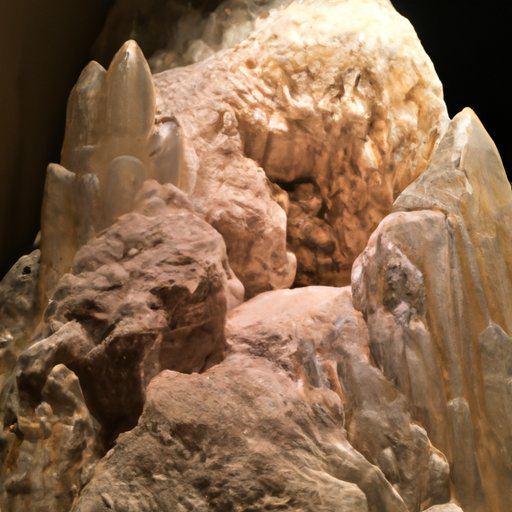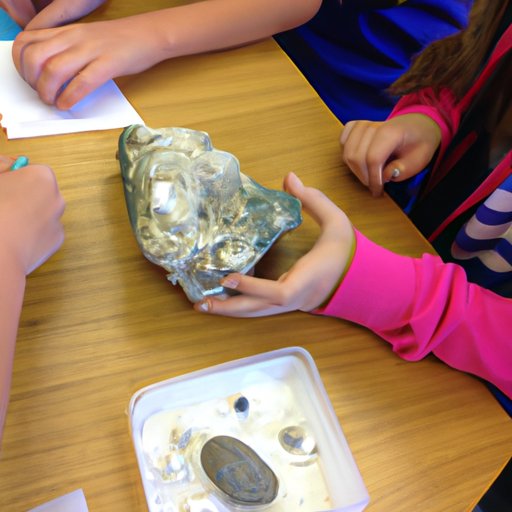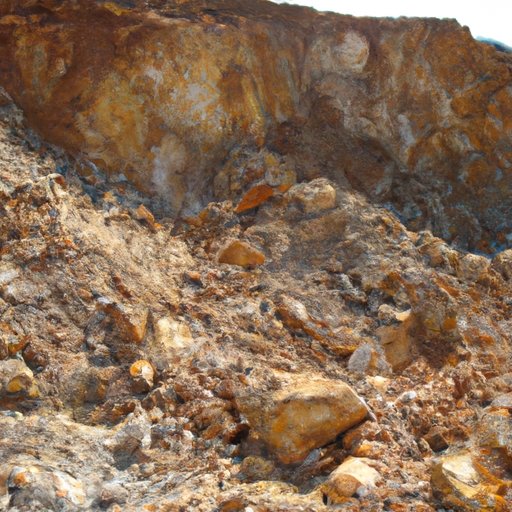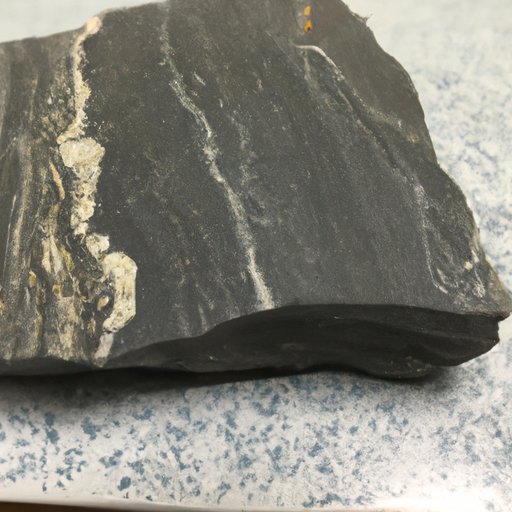Introduction
Rocks and minerals are two words that are often used interchangeably, but they actually have distinct definitions that can help us understand their relationship. Rocks are generally defined as solid aggregates of one or more minerals that form naturally in the environment. On the other hand, minerals are defined as naturally occurring elements or compounds composed of atoms arranged in specific ways that give them unique physical and chemical properties.
In this article, we will explore the different types of minerals that make up rocks, how they are formed, their chemical properties, and the role they play in Earth’s geology. We will also examine the impact of human activity on the composition of rocks and minerals.
Exploring the Different Types of Minerals that Make up Rocks
So what are minerals and what role do they play in the formation of rocks? There are over 4,000 known minerals on Earth, and each one has its own unique properties. Generally speaking, minerals are classified into eight distinct groups based on their chemical compositions: silicates, oxides, sulfates, halides, carbonates, sulfides, phosphates, and native elements. Each of these categories contains a variety of minerals with different characteristics.
What Are Minerals?
Minerals are inorganic substances found in nature that are made up of specific combinations of atoms. They can be either naturally occurring or man-made, and they possess certain properties such as hardness, luster, color, and crystal shape. Minerals are essential to life, as they provide essential nutrients to plants and animals. They are also important components of rocks, which are made up of many different minerals.
Common Minerals Found in Rocks
Some of the most common minerals found in rocks include quartz, feldspar, mica, hornblende, and calcite. Quartz is an abundant mineral that occurs in almost all rock types, and it is composed of silicon and oxygen atoms. Feldspar is the most abundant mineral in the Earth’s crust, and it is composed of aluminum, silicon, and oxygen atoms. Mica is a group of minerals that have a layered structure, and it is composed of potassium, aluminum, and silicate atoms. Hornblende is a dark green to black mineral composed of calcium, magnesium, iron, and aluminum atoms. Finally, calcite is a mineral composed of calcium and carbon atoms.

A Look at How Rocks are Formed from Minerals
Rocks are formed when minerals are combined in various ways. Depending on the conditions under which the minerals are combined, different types of rocks can be formed. The three main types of rocks are igneous, sedimentary, and metamorphic.
Igneous Rock Formation
Igneous rocks are formed when molten material cools and solidifies. This molten material is typically composed of melted minerals, and as it cools, the minerals separate out and form crystals. The type of igneous rock that forms depends on the temperature at which the molten material cools and the minerals that it contains.
Sedimentary Rock Formation
Sedimentary rocks are formed by the deposition and cementation of sediment particles. These particles are typically composed of small pieces of pre-existing rocks, such as quartz, feldspar, and mica. As the sediment accumulates, it is compressed and cemented together to form a new rock.
Metamorphic Rock Formation
Metamorphic rocks are formed when existing rocks are subjected to high temperatures and pressures. This causes the minerals in the rocks to recrystallize and form new minerals, resulting in a new rock with different properties than the original rock.

Investigating the Chemical Properties of Rocks and Minerals
In addition to understanding the different types of rocks, it is also important to understand the chemical properties of rocks and minerals. Rocks and minerals are composed of various compounds, such as silicates, oxides, sulfates, halides, carbonates, and sulfides. Each of these compounds has its own unique properties, which determine the physical and chemical properties of the rock or mineral.
Compounds That Make Up Rocks and Minerals
Silicates are the most abundant group of minerals in the Earth’s crust, and they are composed of silicon and oxygen atoms. Oxides are composed of oxygen and one or more other elements, such as iron and aluminum. Sulfates are composed of sulfur and oxygen atoms, while halides are composed of chlorine, bromine, or fluorine atoms. Carbonates are composed of carbon and oxygen atoms, and sulfides are composed of sulfur and one or more other elements. Finally, native elements are minerals that are composed of only one element, such as gold and silver.
Physical Properties of Rocks and Minerals
The physical properties of rocks and minerals are determined by the compounds that make them up. For example, silicates tend to be hard and brittle, while oxides tend to be softer and less brittle. Similarly, sulfates tend to be soft and easily soluble in water, while halides tend to be harder and not as soluble. Carbonates tend to be soft and easily soluble in water, and sulfides tend to be harder and not very soluble. Native elements tend to have varying properties depending on the element they are composed of.
Examining the Role of Minerals in Earth’s Geology
Minerals are essential components of the Earth’s geology, as they are involved in many geological processes. Minerals can affect the way rocks form, and they can also influence the rate of erosion and weathering of rocks. In addition, minerals can affect the chemistry of the soil, air, and water in an area, as well as the biological diversity of the area.
The Role of Minerals in Geological Processes
Minerals play an important role in the formation of rocks, as they are the building blocks of rocks. They are also involved in the process of erosion, as they can break down rocks through chemical weathering. Minerals can also influence the rate of sedimentation, as they can act as catalysts for the formation of sedimentary rocks. Finally, minerals can also affect the chemistry of the soil, air, and water in an area, as some minerals can release ions that can change the pH and nutrient levels of the environment.
The Impact of Mineral Deposits on Human Activity
Mineral deposits are often sources of wealth for humans, as they can provide valuable resources that can be used in various industries. For example, copper deposits can be mined and used to produce electrical wiring, while iron ore deposits can be smelted and used to produce steel. In addition, mineral deposits can also be used as sources of energy, such as coal and oil, which can be burned to generate electricity.

The Impact of Human Activity on the Composition of Rocks and Minerals
Human activity can also have an impact on the composition of rocks and minerals. Mining is one of the most common activities that can affect the composition of rocks and minerals. This is because mining involves the removal of minerals from the Earth, which can alter the composition of the rocks and minerals in the area.
Mining and Its Effects on the Composition of Rocks and Minerals
Mining can have a significant effect on the composition of rocks and minerals. This is because the removal of minerals from an area can cause the remaining minerals to become concentrated in certain areas, which can lead to changes in the composition of the rocks and minerals. In addition, mining can also cause physical changes to the rocks and minerals, such as fracturing, which can also alter the composition.
Pollution and Its Effects on the Composition of Rocks and Minerals
Pollution can also have an effect on the composition of rocks and minerals. Pollutants, such as heavy metals, can accumulate in rocks and minerals, which can alter their composition. In addition, pollutants can also be absorbed by plants, which can then be passed on to animals, resulting in bioaccumulation of pollutants in the food chain.
Conclusion
Rocks are made up of many different minerals, and each mineral has its own unique properties. These minerals can be grouped into eight distinct categories based on their chemical compositions, and each category contains a variety of minerals with different characteristics. Rocks are formed when these minerals are combined in various ways, and the type of rock that forms depends on the conditions under which the minerals are combined. Rocks and minerals are also composed of various compounds, such as silicates, oxides, sulfates, halides, carbonates, and sulfides. Each of these compounds has its own unique properties, which determine the physical and chemical properties of the rock or mineral. Finally, minerals are essential components of the Earth’s geology, as they are involved in many geological processes, and they can also be sources of wealth for humans.
(Note: Is this article not meeting your expectations? Do you have knowledge or insights to share? Unlock new opportunities and expand your reach by joining our authors team. Click Registration to join us and share your expertise with our readers.)
